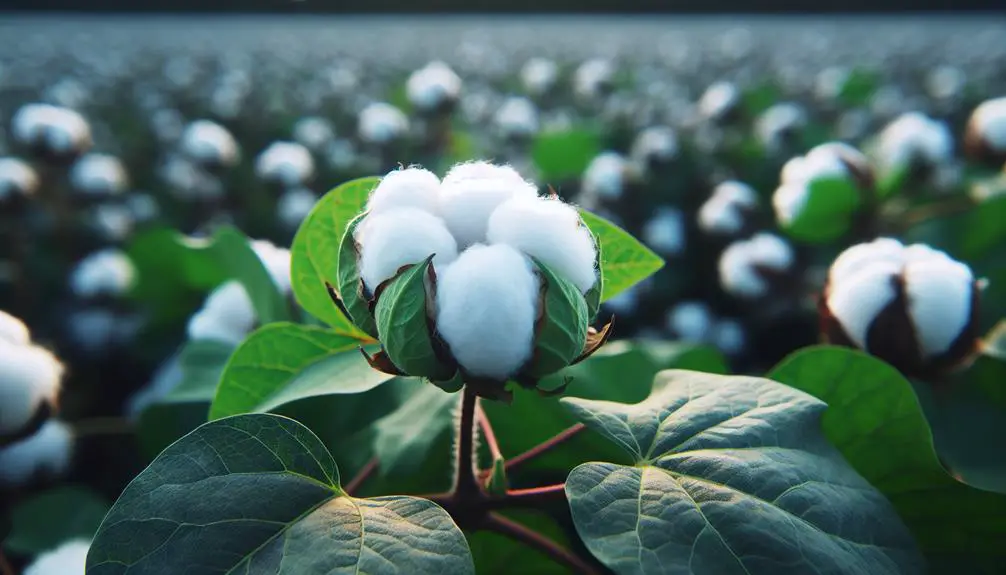I often call cotton 'white gold.' It's an essential natural material famous for its versatility.
Table of Contents
Key Takeaways
- The common name for cotton is simply "cotton."
- Cotton is widely known and referred to by its common name in various languages.
- In everyday conversations, people commonly use the term "cotton" to describe this natural fiber.
- Textile and clothing industries often use the common name "cotton" in their products.
- "Cotton" is the universally recognized term for this versatile and widely used material.
Definition of Cotton
Cotton, with its soft and fluffy fibers that envelop the seeds of the cotton plant, is a natural material widely utilized in textile production. These cotton fibers, also known as lint, are composed of almost pure cellulose, a carbohydrate polymer. The fibers vary in length, with longer fibers typically yielding stronger and smoother yarns, ideal for high-quality textiles.
The cotton plant, scientifically classified under the genus Gossypium, produces these fibers, making it a valuable crop worldwide. Cultivated in over 100 countries, the cotton plant thrives in warm climates with moderate rainfall. Its ability to adapt to different soil types contributes to its widespread cultivation. With the development of hybrid varieties, cotton plants now exhibit traits such as disease resistance and improved fiber quality, enhancing their economic value.
Through centuries of cultivation and innovation, cotton remains a cornerstone in the textile industry, prized for its breathability, comfort, and versatility in garment production. The evolution of cotton farming practices and processing techniques continues to drive the global production and consumption of this essential natural fiber.
Botanical Origin of Cotton
I'll kick off the discussion on the botanical origin of cotton with a focus on cotton plant species and fiber production.
The genus Gossypium, part of the Malvaceae family, encompasses about 50 species that yield the soft, fluffy fibers we associate with cotton.
These plants are prized for their ability to produce the absorbent fibers used in textile manufacturing.
Cotton Plant Species
Derived from various species in the genus Gossypium, the common name for cotton reflects its botanical origin.
- Gossypium arboreum, known as tree cotton, and Gossypium herbaceum, referred to as Levant cotton, are among the species contributing to cotton production.
- Gossypium raimondii, recognized as one of the putative progenitor species of tetraploid cotton, plays an important role in cotton's genetic makeup.
- Gossypium thurberi, also identified as Arizona wild cotton, is another significant species within the Gossypium genus.
Cotton plants from these diverse species are valued for their fiber production, essential for textiles and various other products.
Cotton Fiber Production
Exploring the botanical origins of cotton, the fiber production process reveals the intrinsic qualities of this versatile material. Cotton, derived from the seed pods of plants in the Gossypium genus, with species like Gossypium hirsutum and Gossypium barbadense being the most common for fiber production, boasts softness, breathability, and durability due to its high cellulose content.
The age-old practices of harvesting, ginning, spinning, and weaving cotton into textiles showcase the enduring importance of this natural resource. Its diverse applications in the textile industry for clothing, home goods, and industrial products underscore cotton's significance in our daily lives.
From its botanical roots to the finished product, cotton fiber production embodies a blend of tradition, innovation, and utility.
Characteristics of Cotton Fiber
Cotton fibers are known for their exceptional softness, providing comfort when used in textiles. Their breathability allows air to flow through, making cotton garments ideal for warm weather.
These characteristics make cotton a popular choice for clothing and linens.
Softness of Cotton
Known for its exceptional softness and comfort, cotton fibers are highly regarded in textile production.
- Cotton fibers have a fine and smooth texture that contributes to their luxurious feel.
- The structure of cotton fibers allows them to be gentle on the skin, making cotton fabrics comfortable to wear.
- The softness of cotton is a result of its natural properties, rather than being chemically treated.
Cotton's reputation for softness has made it a staple in the textile industry, favored for its comfort and versatility. Whether used in clothing, bedding, or other textile products, the inherent softness of cotton fibers adds to the overall appeal and desirability of cotton-based items.
Breathability in Cotton
Characterized by exceptional breathability, cotton fibers allow for efficient air circulation and quick moisture evaporation. The unique structure of cotton creates a fabric that's highly breathable, making it ideal for wearing in various climates.
This breathability not only helps in regulating body temperature by keeping the wearer cool and dry but also contributes to the fabric's softness and comfort against the skin. Cotton's natural ability to breathe has made it a popular choice for clothing, especially during warm weather.
The airflow through cotton fibers helps in preventing the buildup of moisture, which can lead to a more comfortable wearing experience. Overall, the breathability of cotton is a significant factor in its popularity and comfort.
Global Cultivation of Cotton
With its extensive cultivation across numerous countries, cotton plays a pivotal role in the global textile industry. China leads the world in cotton production, with India and the United States following closely behind. These three countries are key players in meeting the global demand for cotton.
Additionally, over 100 countries participate in cotton cultivation, showcasing its widespread presence in different parts of the world. India, as the second-largest producer, notably contributes to the global supply, ensuring a steady flow of cotton for various textile applications. Pakistan and Brazil also hold considerable positions in the cotton production landscape, diversifying the sources of this essential textile material.
The cultivation of cotton on a global scale not only supports the textile industry but also influences economies, trade relationships, and consumer goods worldwide.
Common Uses of Cotton
Cotton finds widespread application across various industries due to its versatility and unique properties. In the textile industry, cotton is favored for producing clothing and fabrics because of its comfort, breathability, and resistance to staining.
Beyond textiles, cotton also has medicinal uses such as treating menstrual pains, irregular bleeding, post-birth placental expulsion, lactation issues, and gastrointestinal problems. Additionally, cotton seeds, known for being rich in oil and proteins, have been traditionally used for food, feed, and oil extraction purposes.
Despite the toxicity of gossypol found in cotton seeds to animals and humans, it shows potential as a male contraceptive. The nearly pure cellulose fibers of cotton plants can yield up to 340 kilograms per hectare, making cotton a valuable agricultural crop with diverse applications ranging from textiles to medicine and food production.
Sustainability of Cotton Production
Sustainable cotton production involves implementing practices that reduce water usage, promote soil health, and aim to minimize environmental impact throughout the cotton farming process. To achieve sustainability in cotton production, farmers and organizations can focus on:
- Water Conservation: Implementing efficient irrigation techniques, rainwater harvesting, and water recycling systems to reduce the water footprint of cotton cultivation.
- Pesticide Reduction: Adopting integrated pest management strategies, using natural predators, and rotating crops to minimize the reliance on chemical pesticides and promote a healthier ecosystem.
- Soil Health Promotion: Embracing practices such as cover cropping, crop rotation, and organic fertilization to enhance soil fertility, structure, and biodiversity, ensuring the long-term health of the land.
Frequently Asked Questions
What Is the Real Name of Cotton?
The real name of cotton is 'Gossypium.' It refers to the genus of plants producing cotton fibers. Gossypium includes various species like Gossypium hirsutum and Gossypium barbadense. Understanding this genus is essential for cotton production.
What Is the New Name of Cotton?
The new name for cotton is not a replacement as the common name has stood the test of time. Its scientific name, Gossypium, aligns with its taxonomic classification. This plant remains an essential resource globally.
What Is the Name of the American Cotton?
American cotton is commonly known as Gossypium hirsutum or Upland cotton. It is highly valued for its fiber quality and productivity, being the most cultivated cotton species in the United States and a major contributor globally.
What Is the New Word Species of Cotton?
The new word species of cotton is Gossypium raimondii, also known as Arizona wild cotton. Genome sequencing focused on this species to understand the Gossypium genome better. The aim is a thorough understanding of the cotton genome.
- Why Is Red Velvet Not Red? - April 25, 2024
- How Do You Describe Velvet Fabric? - April 25, 2024
- How Strong Is Velvet? - April 25, 2024




